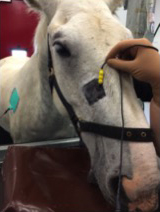Equine Veterinary Journal Early View April 2015
By Heather Ferguson
Neuromodulation using percutaneous electrical nerve stimulation for the management of trigeminal-mediated headshaking: A safe procedure resulting in medium-term remission in five of seven horses
Roberts V.L.H, Patel N.K and Tremaine W.H
This case series set out to investigate the potential use of a novel therapeutic intervention for trigeminal-mediated headshaking. Seven horses affected by headshaking to a degree of at least 2/3 on the author’s scale underwent a standard diagnostic protocol including diagnostic local anaesthesia of the infraorbital branch of the maxillary nerve. Other treatment methods had previously been employed in these horses without success.
The treatment involved perineural placement of a percutaneous electrical nerve stimulation (PENS) probe approximately 1mm superficial to the infraorbital nerve, performed under standing sedation. The probe was used to apply voltages extrapolated from human studies which were intended to stimulate the nerve, with stimulation being indicated by facial twitching. This procedure was performed bilaterally. A total of 24 procedures were carried out on the 7 horses with treatments being repeated in individual horses at varying intervals depending on the length of time for which remission of signs lasted following each treatment. The criteria for treatment success was defined as return to ridden work at the level prior to onset of headshaking.
The procedure was well tolerated with mild adverse effects noted in some horses (namely haematoma formation at the probe insertion site and transient increase in severity of clinical signs). The first treatment resulted in the temporary remission of clinical signs in 6 of the 7 horses. Median remission time increased with each treatment performed: 3.8 days following the first treatment, 2.5 weeks following the second treatment, 15.5 weeks following the third treatment and 20 weeks following the fourth treatment. One horse failed to respond to three treatments.
These results are encouraging and further studies are required to refine the technique and determine the optimal voltages required for trigeminal nerve stimulation and to further elucidate the aetiopathogenesis of headshaking and the mechanism of action of PENS therapy.
Bottom line:
Repeated treatments with percutaneous electrical nerve stimulation therapy are relatively safe and may result in resolution of the clinical signs of trigeminal-mediated headshaking in the medium-term. The length of time of remission seems to increase following each successive treatment.
--Ends--


